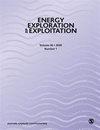Research on the molecular dynamics of coalbed methane diffusion and adsorption in reservoir pores under different factors
IF 1.6
4区 工程技术
Q4 ENERGY & FUELS
引用次数: 0
Abstract
The migration and diffusion of coalbed methane (CBM) are impeded by adsorption in pore channels, resulting in a significant portion of CBM being trapped in the reservoir and thereby reducing the efficiency of CBM extraction. Investigating the adsorption and diffusion behavior of CBM in reservoirs is crucial for optimizing CBM extraction. In this study, we developed a theory based on the basic geological characteristics of coal beds and the adsorption state of CBM, focusing on the transition state of adsorption gas diffusion of surface diffusion gas molecules. We explored the impact of various factors on the diffusion coefficients and adsorption capacity of CBM, elucidating the underlying reasons for variations in CBM adsorption and diffusion through molecular dynamics simulations. Our findings reveal that CBM undergoes simultaneous adsorption and desorption on the surface of coal beds, with adsorption conforming to the Langmuir monomolecular layer adsorption. Increasing reservoir temperature leads to a reduction in methane adsorption and a gradual increase in diffusion coefficient. For instance, at 80 °C, methane adsorption decreases to 0.5 mg/m不同因素下煤层气在储层孔隙中扩散和吸附的分子动力学研究
煤层气在孔隙通道中的吸附阻碍了煤层气的迁移和扩散,导致很大一部分煤层气被困在储层中,从而降低了煤层气的抽采效率。研究储层中煤层气的吸附和扩散行为对于优化煤层气开采至关重要。在这项研究中,我们根据煤层的基本地质特征和煤层气的吸附状态建立了一套理论,重点研究了表面扩散气体分子的吸附气体扩散过渡状态。我们探讨了各种因素对煤层气扩散系数和吸附能力的影响,通过分子动力学模拟阐明了煤层气吸附和扩散变化的根本原因。我们的研究结果表明,煤层气在煤层表面同时发生吸附和解吸,吸附符合朗缪尔单分子层吸附。储层温度升高会导致甲烷吸附量减少,扩散系数逐渐增大。例如,在 80 °C 时,甲烷吸附量减少到 0.5 mg/m3,而扩散系数则增加到 4 × 10-9 m2/s。此外,煤层中水的存在会大大削弱煤层气的吸附能力,含水量为 0.5% 时,吸附能力最低为 0.5 mg/m3。此外,增加煤层压力可提高煤层气吸附能力,但会降低扩散系数。例如,储层压力为 30 兆帕时,煤层气吸附能力增加到 0.65 毫克/立方米,而扩散系数却降低到 2.5 × 10-9 平方米/秒。总之,我们的研究表明,温度、含水量和压力等地质条件对煤层气吸附和扩散行为的形成起着至关重要的作用。通过了解这些环境因素,我们可以有效地控制煤层气的扩散和吸附能力,从而为煤层气的开采提供重要的见解和基础数据。
本文章由计算机程序翻译,如有差异,请以英文原文为准。
求助全文
约1分钟内获得全文
求助全文
来源期刊

Energy Exploration & Exploitation
工程技术-能源与燃料
CiteScore
5.40
自引率
3.70%
发文量
78
审稿时长
3.9 months
期刊介绍:
Energy Exploration & Exploitation is a peer-reviewed, open access journal that provides up-to-date, informative reviews and original articles on important issues in the exploration, exploitation, use and economics of the world’s energy resources.
 求助内容:
求助内容: 应助结果提醒方式:
应助结果提醒方式:


